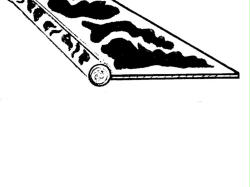1940-1941 Plymouth Car

We are glad to add these cars to our line of products. We will be adding more items as we get them in stock Call us for any items you do not see. 1-888-762-7776
The development of the 1940 Dodge had its roots in the company's history. From the time of its absorption into Chrysler, the Dodge lineup began to change and evolve.
 Period Dodges, like the 1941 Custom Town Sedan, were very down-to-earth automobiles. See more pictures of Dodges. |
The hard-drinking Dodge Brothers, John and Horace, who had set out to build a Ford-beater in 1914, found their logical successors in the hard-driving Chrysler team: Walter Percy Chrysler, K. T. Keller, and the engineering triumvirate of Fred Zeder, Owen Skelton, and Carl Breer.
Stories abound of Chrysler's taking over Dodge in July 1928 from the New York banking firm of Dillon, Read & Company, which had bought the Hamtramck, Michigan, carmaker three years earlier. The best one is how Keller had the factory signs changed overnight to read "Chrysler Corporation-Dodge Division."
The next morning, Clarence Dillon, representing the sellers, phoned Walter Chrysler to assure him that Dodge was in good shape, and would "run itself for three months." Chrysler replied, "Hell, Clarence, our boys moved in yesterday." Still, Dillon must have been delighted, since W.P. Chrysler had paid him $170 million.
Though the Dodge Brothers badge didn't disappear until 1939, there was little doubt the business belonged to Chrysler from 1928 forward -- and that it had been a good buy. Under John and Horace, Dodge would have considered a 100,000-car year phenomenal.
 After a year without a convertible, the 1940 Dodge lineup resumed the style. |
After weathering the Depression, Chrysler was able to start producing more than 200,000 Dodges a year starting in the late 1930s. But while Chrysler and DeSoto were occasionally innovative with products like the Airflow, Dodge remained resolutely conservative.
This was no less true of the 1940-1948 models, which maintained the traditional Dodge virtues of practical durability and honest dollar value. There was no question of daring designers risking all on a radical styling departure, or madcap racing drivers trouncing the opposition, or a fervent "engineers' car company" blowing everybody else away with some technical breakthrough.
What we have here are good, solid cars, probably the best Dodges built to that time, cars that made Dodge-Plymouth dealers rich beyond their imaginings.
In those days, every Chrysler, DeSoto, and Dodge dealer sold Plymouths too, but the Dodge-Plymouth stores easily did best because Dodge always outsold Chrysler and DeSoto. Even now, Dodge is a Chrysler -- well, Daimler-Chrysler -- powerhouse, with annual sales volume that would have been unbelievable in the 1940s. Plymouth, meanwhile, is vanishing after some seven decades, apparently in the name of progress.
 In 1940, Dodge DeLuxes featured bright trim on the beltline and running boards. |
Dodge changed more in the early 1930s than it did in the 1940s, beginning with market strategy. Four-cylinder cars were swept aside under Chrysler, which presided over introduction of the first Dodge Six, in 1929, followed by an Eight a year later.
Then W.P. Chrysler decided to imitate the successful General Motors formula of strict price territories for each make in the fold. Thus, from a market position both above and below DeSoto's, Dodge in 1934 became a less-expensive product one rung above Plymouth. The only engine was a 218-cid six that churned out 87 bhp until 1941, when it was bumped to 91. A longer stroke for 1942 produced 230 cid and 105 bhp.
Division marketers dreamed up imaginative names for most of the yearly lineups with hopes of making the ordinary seem special: "New Standard" for 1934, "New Value" for 1935, "Air-Styled" for 1936, "Luxury Liner" for 1939.
Wheelbases ran 115-117 inches, but Dodge also built handfuls of limousines and long sedans. Among them was the first Dodge Caravan; a 1935-only, five-passenger, trunk-back sedan on a 128-inch chassis.
Briefly, Dodge was poised to take a more interesting course. Like their Ford and General Motors colleagues, Chrysler engineers pursued a number of radical concepts in the early 1930s, including streamlined compacts, front-wheel drive, and five-cylinder radial engines.
But they also developed Airflow-styled Dodges and Plymouths to follow the Chrysler and DeSoto versions and complete a planned all-Airflow corporate line. The smaller Airflows got as far as full-scale mockups ready for tooling, only to be killed at the last minute by the senior models' poor public reception in 1934. With that, Chrysler Corporation beat a hasty retreat to safe, middle-of-the-road design, and wouldn't stray from it for 20 years.
Yet Dodge was not without innovations in the 1930s. Overdrive, steel artillery wheels, independent front suspension ("Floating Cushion Wheels") and "Draft-Free" ventilation all arrived for 1934.
The following year saw a kind of precursor to today's "Cab Forward Design," as the engine was shifted eight inches ahead and the front seat almost as far to create a capacious rear compartment that put occupants well ahead of the rear axle (all rather like the Airflow).
For 1937 came no-snag outside door handles, lower drive-shaft tunnels, built-in defroster vents, "safety" recessed dash knobs and flush-mounted instruments, and-famously-rubber body mounts. The 1938s introduced an important new transmission, Fluid Drive.
Continue on to the next page to read about the developments in the 1940-1942 Dodge.
-
Goes between body and fenderPrice: 43.26
-
Fits most Dodge trucks 1933-1947 & and Plymouth trucks 1937-1941Price: 55.0
-
Fits most Dodge trucks 1933-1947 & and Plymouth trucks 1937-1941Price: 55.0
-
Fit most Dodge trucks from 1933-1947 & Plymouth 1937-1941Price: 22.0
-
All steel constructionPrice: 86.25
-
Price: 86.25
-
All steel constructionPrice: 299.25
-
Does not include inner rockerPrice: 299.25
-
Price: 215.0
-
Price: 215.0
-
Price: 775.0




